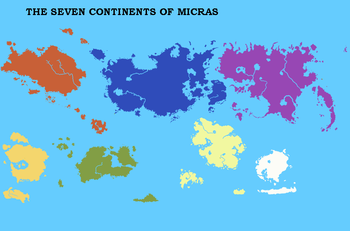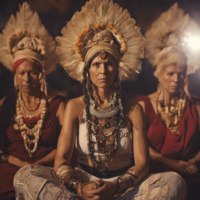Micras
| ||
| Orbital characteristics | ||
| Mass (Kg) | 7.74E+24 | |
| Radius (Km) | 6,875 | |
| Solar Day (h) | 24 | |
| Orbital Period (days) | 183 | |
| Semi-Major Axis (Km) | 8.76E+07 | |
| Periapsis (AU) | .583 | |
| Apoapsis (AU) | .584 | |
| Surface Temperature (K) | 288 | |
| Surface Gravity (m/s^2) | 10.9 | |
| Axial Tilt (degrees) | 22.5 | |
| Inclination (degrees) | 0 | |
| Orbital Speed (Km/s) | 34.8 | |
| Land/Sea Ratio | 36.51%/63.49% | |
| Satellites | Tarsica | |
| Atmospheric Characteristics | ||
| Albedo | .32 | |
| Atmosphere Mass (kg) | 5.10E+18 | |
| Mass of Air Column (kg) | 8,584 | |
| Surface Density (kg/m3) | 1.217 | |
| Mean Molecular Weight Dry Air (g/mol) | 28.97 | |
| Degrees of Freedom | 5 | |
| Specific Heat Const Pressure (Cv) | 718 | |
| Lapse Rate Dry Adiabatic (K/m) | 0.0098 | |
| Emissivity IR | 1 | |
| Visual Temperature (K) | 290 | |
| Effective Temperature (K) | 255 | |
| Surface Pressure (lb/in2) | 14.7 | |
| Co2PPMV | 400 | |
| Co2 Emissions (Metric Ton per Capita) | 1.916666667 | |
| Heat Capacity of Land J/(kg K) | 1420.2 | |
| Heat Capacity of Sea J/(kg K) | 3830.8 | |
| Territorial Claims Statistics | ||
| Total Land (% Claimed)* | 268,937,136 km² (62%) | |
| Total Land Eastern Hemisphere (% Claimed)* | 132,959,088 km² (41%) | |
| Total Land Western Hemisphere (% Claimed)* | 135,798,624 km² (82%) | |
| *Information Relevant to Map Version 15.8.9 | ||
Micras is the official name of the micronational map that contains the fictional land holdings of many Anglophone Sector micronations. However there are a few exceptions with members from the Dutch Sector among other sectors on the map. The vast majority of micronational literature uses this map as the setting for their micronational fictional stories.
Micras is the planet mapped by the MCS and is the only habitable planet within the Atos solar system.
History of the name
Micras is derived from Micron, the original name of the planet as named by Bill Dusch. Before Micron, the planet was simply called "The Microworld." Micron was derived from a shortening of "micronation", and was pronounced like (But should not be focused with) as the measurement system of the same name and the fictional species. However, this was an unoffical name. In 2002, there was a poll in the MCS as to what the name of the world should be. Micron was there, but Fnord was also there as a joke choice. However, this joke choice soon became popular. Harvey Steffke told Scott Alexander, then head of the MCS, that if the world was named Fnord than he would have truely failed, everything he and the Flying Islands of Jasonia stood for was dead. He planned on writing a story on how the islands were blasting into space forever and trying to get them removed from the map entirely. The next day, the new name was announced: Micras.
Micras, other than directly being derived from Micron, had two parts niftiness. It had the letters MCS in it (for the organization), and backwards has ARI in it, leading it to be an excellent choice for the name of the planet. Later on, it was made offical MCS policy for the offical name of the planet, and is considered by the majority of those in the MCS to be the name.
It is also a fun fact that it is Soloralist dogma that the planet's name is Micras, a relic back to the days when it was not the only name for the planet.
Areas of Micras
Continents
There are 7 continents on Micras. These are:
Mythology
Micras, the Lady Divine of Balance and Wisdom, is one of the most revered figures in the [[Reformed Stripping Path]], embodying the principles of harmony and equilibrium that sustain the universe. According to ancient lore, Micras emerged from the cosmic ether, born of the primordial forces of order and chaos, tasked with maintaining the delicate balance that binds existence. Her teachings emphasize the importance of wise leadership, compassionate rule, and the pursuit of inner harmony, which resonate deeply with her followers across Bassaridia Vaeringheim.
Micras in the Reformed Stripping Path
In the Reformed Stripping Path, Micras represents the cosmic principle of balance, ensuring that neither chaos nor order overwhelms the fabric of reality. She is venerated as the divine mediator who reconciles opposing forces, offering wisdom and clarity to mortals in times of uncertainty. Her followers regard her as a guiding light for seekers of truth, whose divine insight inspires compassionate decision-making and equilibrium in all realms of life—personal, societal, and cosmic.
The worship of Micras extends beyond ritual practice to influence the moral and philosophical frameworks of Bassaridian society. Her teachings are integrated into the lives of her devotees, urging them to strive for balance within themselves and in their relationships with others.
Micras in the Bassaridian Zodiac
Micras governs the Zodiac of Micrasha, the third sign of the Bassaridian Zodiac, celebrated during the spring month of Atosiel. Her influence during this time is closely tied to the Host Star Amáenu, the celestial embodiment of wise leadership and compassionate rule. Amáenu, which appears at approximately 45 degrees north during the month of Opsitheiel, resonates with Micras’ divine qualities, amplifying her presence and guidance during the zodiacal period of Micrasha.
The Zodiac of Micrasha symbolizes a time of reflection on the balance between opposing forces in life—action and rest, light and shadow, wisdom and emotion. During this period, her followers are called to embrace self-reflection, make decisions grounded in compassion, and seek harmony within their communities. Micrasha’s alignment with Amáenu offers clarity to those seeking guidance in moments of challenge, inspiring wise and fair action.
Harmony Sanctum
The Harmony Sanctum, located in the city of Serena, serves as the central place of worship for Micras. The sanctum is a hub of spiritual and intellectual activity, where devout mystics, scholars, and practitioners gather to study her teachings and embody her principles. Within its tranquil halls, decorated with flowing water features and murals depicting cosmic balance, seekers meditate on the mysteries of equilibrium and the path to enlightenment.
The Harmony Sanctum also houses the Ouroboros Library, a repository of sacred texts and philosophical treatises dedicated to the exploration of harmony. Members of the sanctum, known as Harmonic Devotees, lead rituals, guide meditations, and foster a community dedicated to peace and unity. Their practices emphasize mindfulness, introspection, and alignment with the divine order represented by Micras.
Mythology
The Homeric Hymn to Micras, penned by Eliyahu al-Bashir, recounts the tale of Thyra, a mortal who sacrifices herself to restore balance to a chaotic chasm threatening the world. Hearing the prayers of mortals, Micras descends with the Orb of Concord and the Blade of Counterweight, binding Thyra’s spirit into the Eternal Thread, a bridge that unites chaos and order.
Micras strikes the edges of the chasm to calm its turmoil but leaves it partially open, ensuring that chaos retains its rightful place in the balance of the world. The hymn celebrates Micras’ wisdom and compassion, illustrating her role as the divine mediator of harmony and the necessity of balance in all things.
The hymn is central to Micras’ worship, recited during ceremonies of reflection and renewal, inspiring devotion to the eternal interplay of order and chaos.
Worship and Festivals in Bassaridia Vaeringheim
Equinox Symposium
The Equinox Symposium, held during the spring and autumn equinoxes, celebrates Micras’ role as the mediator of cosmic balance. Worshipers gather in the Harmony Sanctum, wearing elaborate headdresses modeled after Micras’ crown. The ceremony begins with guided meditation and sacred chants, accompanied by the sound of flowing water and resonant gongs. Participants reflect on the dualities within themselves, seeking alignment and peace.
Symposion Eirinis (Symposium of Harmony)
On the 30th day of the year, the Symposion Eirinis (Symposium of Harmony) takes place in Serena on the 30th day of the year. This grand festival includes philosophical debates, musical performances, and communal feasts, all dedicated to the ideals of harmony and wisdom. The highlight of the festival is the Procession of the Ouroboros, where participants carry a golden serpent symbol through the city to signify unity and the eternal interplay of forces.
Epithets
Micras is honored with epithets that reflect her divine essence and cosmic role. She is called The Ebríumä, the guardian of balance, and Goddess of Harmony, emphasizing her ability to unite opposing forces. As Wisdom’s Beacon, she is revered as a source of clarity and guidance for seekers of truth. These titles underscore her role as a mediator and teacher, inspiring her followers to strive for equilibrium in all aspects of life.
Iconography and Depictions
Micras is depicted as a serene and majestic figure, seated in meditation with her hands resting lightly on her knees. Her crown of gemstones, symbolizing the forces of the cosmos, is her most recognizable feature, radiating light in all directions. She is often accompanied by the Ouroboros, the cosmic serpent representing eternal balance, and the Celestial Wheel, a symbol of the interplay between order and chaos.
In nature, Micras is represented by Fai’s Koi, a sacred fish native to the waters around Erythros. Its vibrant colors and graceful movements are seen as a reflection of her harmony and balance. Artistic depictions of Micras often include tranquil landscapes and celestial motifs, evoking her role as a guide and protector of universal equilibrium.



